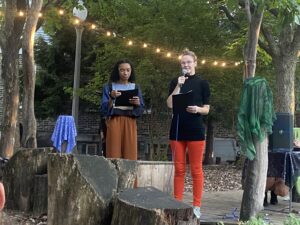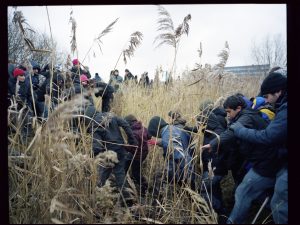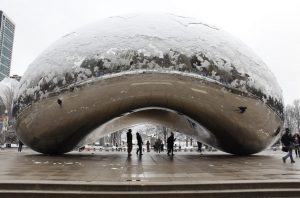 Every so often, Sallie Gordon, driving force behind the Growing Station Community Garden group in Pilsen, goes to an abandoned lot located near the garden between Peoria Street and Cullerton Street, only a block away from the Walsh School, to pick up trash.
Every so often, Sallie Gordon, driving force behind the Growing Station Community Garden group in Pilsen, goes to an abandoned lot located near the garden between Peoria Street and Cullerton Street, only a block away from the Walsh School, to pick up trash.
Gordon has taken it upon herself to take care of the small lot known as the Lowenthal Site, so she periodically combs the property, picking up any trash and debris that might render it an eyesore or pose a danger to children who walk across it. However, every day Gordon picks up around the lot, she says she puts her life in further danger. The empty lot, much like most of the land in the area, contains an unhealthy amount of lead, posing severe health risks to children and pedestrians who walk across it.
“I think this whole strip of land is lead, and right now I don’t even know who owns [all of it],” said Gordon. “I’m probably going to die of lead poisoning because I’ve been planting stuff here. The so-called weeds actually protect people from lead the taller they are.”
Unfortunately, Gordon said the land has been sprayed with herbicides to kill the weeds, leaving raw, toxic earth for unsuspecting people to walk across, exposing themselves to hazardous amounts of lead in the process.
Jerry Mead-Lucery, an activist with PERRO who gives weekly tours through Pilsen to demonstrate the community’s environmental difficulties, said an old lead smelting factory used to stand on the plot of land, which is now bisected by a railroad and serves as a general open area where people walk and play.
“Nobody knew about it, and it has just been a field since,” said Lucery. “Kids walk across it because they’re coming from the Walsh School, coming from the garden. Only recently were we made aware of this whole lead smelter that was never remediated.”
Lucery said nobody knew about the old lead factory until a researcher in the 90s began documenting old smelters that had been left out of the EPA database. When the EPA discovered the study, they took lead samples on site and discovered the highest lead concentration in the community yet at 26,000 parts per million, more than 25,000 ppm above the safe level of 400. But then, “for some reason it never went any further than that,” said Lucery.
Despite recognition of the problem, PERRO and other environmentally conscious community members have faced resistance from the BNSF Railway Company because they own the lot and don’t have any intention to remediate in the near future, according to Lucery and Gordon.
“The EPA is trying to do testing here, but the railroad is a terrible neighbor and even the alderman can’t get them to do much,” said Lucery. “We’ve done testing and gotten the results ourselves, but there’s a limit to what federal agencies can do with them because we don’t have permission.”
The struggle comes after PERRO’s recent announcement in January that the H. Kramer company, Chicago’s leading polluter of airborne lead, will be forced to install new pollution control equipment that should reduce the amount of lead it puts into the environment to “a very low level”, according to PERRO’s website.
However, the uphill nature of PERRO’s battle against environmentally ignorant manufacturers and power plants underscores another problem: the close proximity of notoriously negligent polluters and decades of emissions accumulating in the atmosphere mean an acutely harmful environmental effect that won’t go away any time soon.
“One of the community’s problems is cumulative impact,” said Lucery. “Fisk and Kramer and others are all concentrated in a small area. When you have a bunch of polluters in a small area near houses and apartments, that creates a unique problem.”
According to a 2010 Clean Air Task Force study, Illinois ranked 7th on a national scale as a state heavily affected by power plant-related mortalities, hospital admissions and heart attacks. That year 621 people died of power plant-related problems, 455 were admitted to the hospital and 1,018 had heart attacks.
The study also stated the Chicago-Naperville-Joliet metro area places third nationally in terms of factory-related acute health impacts.
So it isn’t a surprise that people like Leila Mendez, a Pilsen resident who has lived near the Fisk Power Plant for 46 years and member of PERRO, have suffered curious health issues.
According to Mendez, she and her family have encountered a slew of strange health problems including bizarre allergies, emphysema in relatives who never smoked, thyroid cancer and tumors
However, Mendez said respiratory issues are the most salient in the community.
“The people in my family whose health has been affected are the ones who have lived here,” said Mendez. “Respiratory problems are very common here. You hear so many people talk about it.”
But with organizations like PERRO finally making strides toward clean air in Pilsen and the Greater Chicago area, the fight may need to be relocated to the ground where lead still sits and directly impacts oblivious children.
For the time being, people like Gordon, who have put their heart into bettering the community, feel wronged by the environmental problems facing residents and the health risks they pose.
“Local politicians [helped us in building] this garden and said we could have the space and would be in charge of taking care of it, and that was cool in a naive way, but finally after five years of complete neglect and realizing all the pollution, it was like a bell went off. They betrayed me. Anyway, I have a beautiful garden,” said Gordon.


















Be First to Comment